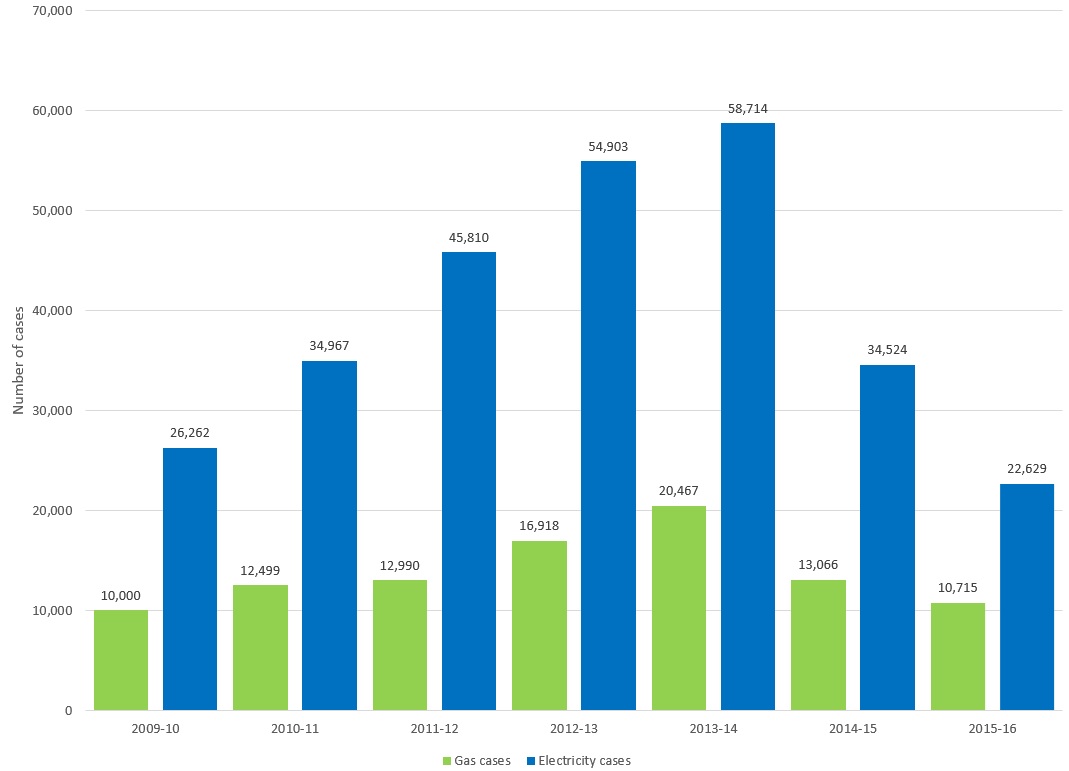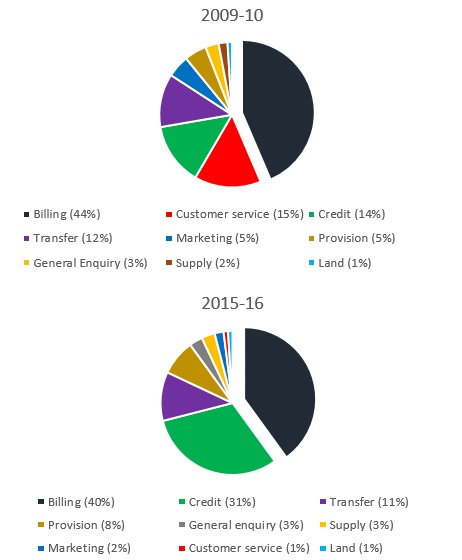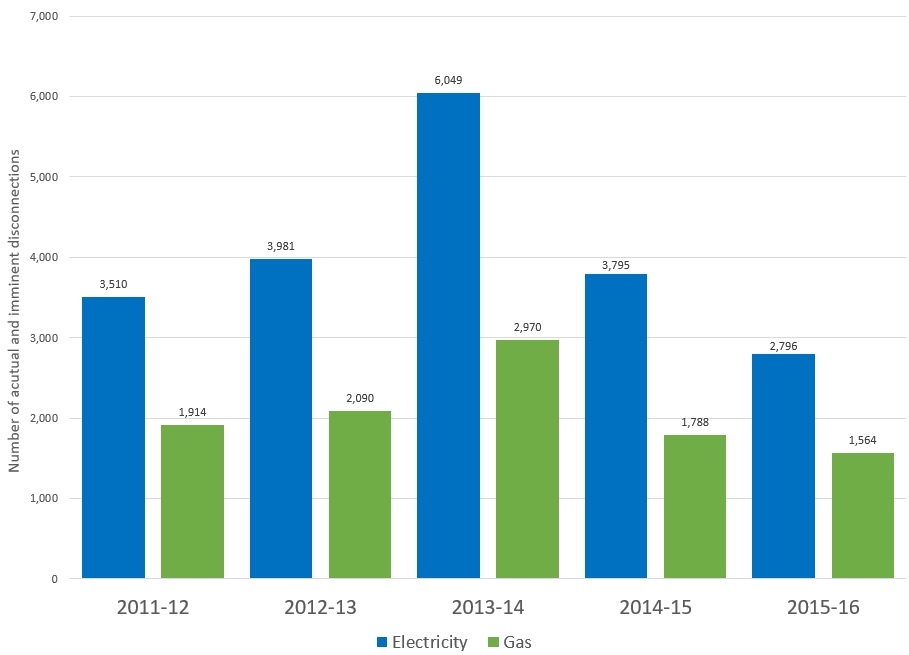Retailers continue to improve in Victoria
For a second year running the number of electricity and gas disconnection cases decreased according to the Energy and Water Ombudsman (Victoria) (EWOV) 2016 Annual Report[i]. This result demonstrates the shift in approach by energy retailers who are taking a more customer-focused path towards resolving affordability issues.
Although the Ombudsman remains concerned about energy affordability, it is unclear whether the Victorian Essential Services Commissions (ESC) new ‘payment difficulty framework’ is required[ii]. The detail of the new framework and how it will be rolled out to retailers is not clear, however it’s expected any new requirements would increase the cost of potential system changes. The new framework could also confuse consumers and lead to increased complaints hindering the productive work retailers have done to date.
Energy and Water Ombudsman (Victoria) (EWOV) annual report
According to the EWOV report Victoria has seen fewer problems with billing systems and better internal dispute resolution by energy companies for FY2015-16. This has delivered a decrease of 34 per cent in electricity cases and 18 per cent in gas cases in FY2015-16 on year ago levels. Figure 1 highlights the electricity and gas cases received by EWOV between FY2011-12 and FY2015-16[iii].
Figure 1: Electricity and gas cases received by EWOV between 2011-12 and 2015-16

Source: Energy and Water Ombudsman Victoria (EWOV), 2016, “2016 EWOV Annual Report”
The majority of the 22,629 electricity cases were either billing or credit issues. Figure 2 highlights that credit issues formed 31 per cent of the total issues raised by electricity customers in FY2015-16. The Ombudsman remains concerned with these figures as it is a significant increase from credit issues making up 14 per cent of electricity issues raised in FY2009-10. In FY2015-16 there were 9,136 (40 per cent of issues raised) billing issues which were on high bills, back bill, refunds, fees and charges. Credit remained the second biggest source of customer complaints with 6,987 credit issues logged (31 per cent of issues raised), a result of disconnection and payment difficulties. In regards to gas cases, billing and credit issues also accounted for over 60 per cent of the issues raised[iv].
Figure 2: Issues raised by Electricity Customers

Source: Energy and Water Ombudsman Victoria (EWOV), 2016, “2016 EWOV Annual Report”, Energy and Water Ombudsman Victoria (EWOV), 2010, “2010 EWOV Annual Report”
Disconnection has always been a last resort for retailers. Falls in electricity and gas disconnection cases are showing signs that energy retailers having taken more of a customer-focused approach to affordability issues before they start the disconnection process and that this has been effective. EWOV results show that credit-related actual and imminent energy disconnections cases for electricity and gas have dropped by more than 50 per cent since FY2013-14.[v]
Figure 3: Credit-related actual and imminent disconnection restrictions

Source: Energy and Water Ombudsman Victoria (EWOV), 2016, “2016 EWOV Annual Report”
The FY2013-14 results led to a significant increase in actual and imminent disconnections, which resulted in the ESC conducting an inquiry and producing a report on the best practice financial hardship programs of energy retailers.
The final report of the ESC’s inquiry into retailer assistance measures for energy customers in financial hardship was released in March 2016. The Victorian Energy Minister endorsed the recommendations, and the ESC then commenced what was to be an implementation program for the new ‘payment difficulty framework’ to commence on 1 July 2017[vi].
What next?
Since the announcement of the proposed ESC framework, electricity and gas disconnections cases have continued to decrease. It currently remains unclear how the new framework’s implementation process will work and if it is required. There are uncertainties regarding the detail of the new framework and how it will be enforced and it could potentially increase the cost of system changes. The new framework could also confuse consumers and lead to an increase in complaints, hindering the productive works retailers have currently done.
Energy retailers also continue to develop hardship programs for customers experiencing financial difficulty. According to EWOV the fall in credit cases can be attributed to more attention from energy retailers to prevent less complex hardship complaints escalating. Despite the decline in cases since 2013-14, credit issues regarding disconnection continue to be top of the list of customer concerns. Retailers plan to continue to reduce affordability and hardship complaints through the provision of effective hardship support, offering sustainable payment plans, improving communications and customer engagement and generally providing better customer support. More work is still required to decrease customer complaints, however, a key will be collaboration between retailers, government and regulators.
[i] Energy and Water Ombudsman Victoria (EWOV), 2016, “2016 EWOV Annual Report”.
[ii] Victorian Essential Services Commission (ESC), 2016, “Support Customers, Avoiding Labels - Energy Hardship Inquiry Final Report”.
[iii] EWOV, 2016, Op.Cit
[iv] EWOV, 2016, Ibid.
[v] EWOV, 2016, Ibid.
[vi] ESC, 2016, Op. Cit
Related Analysis
2025 Another Year Full of Energy (Developments)
2025 has been another year in which energy-related issues have been front and centre. It ended with a flurry of announcements and releases, including a new Solar Sharer tariff proposed by the Federal Government and the release of the 2026 Integrated System Plan (ISP) draft. Below we highlight some of the more notable developments over the past 12 months.
Getting it right: How to make the “Solar Sharer” work for everyone
On paper, the government’s proposed "Solar Sharer Offer" (SSO) sounds like the kind of policy win that everyone should cheer for. The pitch is delightful: Australia has too much solar power in the middle of the day; the grid is literally overflowing with sunshine: let’s give households free energy during 11am and 2pm. But as the economist Milton Friedman famously warned, "There is no such thing as a free lunch." Here is a no-nonsense guide to making the SSO work.
Energy Affordability: Will Solar Sharer reduce energy costs?
Energy affordability has been a hot topic for the last few months. Whilst the first term of the Albanese Government could be characterised as being focused on shifting the narrative on renewables development, it seems likely that its second term will need to consider how to deal with affordability, for both households and businesses. So what is the likely direction of travel for energy prices in the medium term, and is there anything industry and consumers can do to minimise the impacts? And can measures like the announced Solar Sharer help?
Send an email with your question or comment, and include your name and a short message and we'll get back to you shortly.



